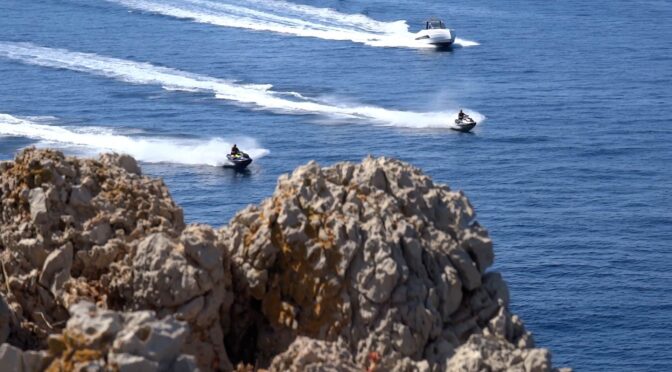Views: 161
The high density of boats along Menorca’s coastline during the summer is causing safety concerns for swimmers and other beachgoers. The constant speed and noise also negatively impact the marine environment.
A few weeks ago, the Maritime Captain of Menorca warned about the chaos in the island’s waters during the summer. The increase in moorings at ports and anchoring buoys along the coast has been compounded by heavy activity at boat ramps, used not only by individuals but also by companies.
In 2007 and 2008, the environmental group GOB launched a campaign titled “Jo dic PIC” (“I say Insular Coastal Plan”). In 2009, a promising process of coordination among administrations and stakeholders regarding coastal activities began, funded by the Ministry overseeing coastal areas. These meetings achieved significant consensus and helped organize particularly chaotic areas, like the beach at Es Grau. Aerial surveys were also conducted to count the number of boats around Menorca. However, the political change in 2011 halted this progress, and the initiative has not been revived since.
GOB continues to advocate for a plan to regulate and rationalize the use of boats along the coastline, a proposal included in Menorca’s Territorial Plan under the title “Coastal Management Plan,” which would serve as a Sectoral Master Plan.
Nautical carrying capacity already exceeded
In 2020, the Balearic Islands’ General Ports Plan was approved, including a study on the nautical carrying capacity of each island outside of ports. Comparing the carrying capacity of Menorca’s various coves and beaches (2,115 boats) with the number of boats detected during a 2010 aerial survey (2,344 boats), it’s clear that the carrying capacity has been exceeded for over 14 years.
Given these official data and the public acknowledgment of the need for improved safety conditions, it’s crucial to restart efforts to bring together the relevant coastal administrations to rationalize maritime activities.
Swimmers: the forgotten majority
Among the current regulatory deficiencies, overcrowding, and lack of effective supervision, there is one group that often gets overlooked because no economic sector represents them: the swimmers. People who access the sea from the shore make up the largest group of coastline users, yet they are rarely included in decision-making processes. Authorities should recognize the high risk of accidents when boats fail to maintain safe distances or neglect to reduce speed to safe levels.
High speeds also have significant environmental impacts, such as disturbing the seabed and increasing water turbidity, while noise pollution can greatly affect marine life.
Slowing down, increasing protection, and enhancing supervision
GOB and Mallorca Blue have recently released a video showing boats speeding dangerously close to other users. They call for the extension of the speed-restricted zone from the current 50 meters from the shore to 300 meters, similar to regulations in France.
The protected areas for swimmers should also be significantly larger than they typically are. In some coves and beaches, boats come too close to where people are swimming, posing an obvious danger. Local councils can request that coastal authorities place buoys at a greater distance from the shore.
At sea, just like on roads, there are vehicles that must follow rules. However, unlike on land, there is almost no supervision at sea. Therefore, the government needs to establish services to monitor these activities or provide a way for individuals to report violations.
Nautical activity has grown significantly in recent decades, and now is the time to rationalize, resize, and ensure it remains compatible with the environment and other users.

